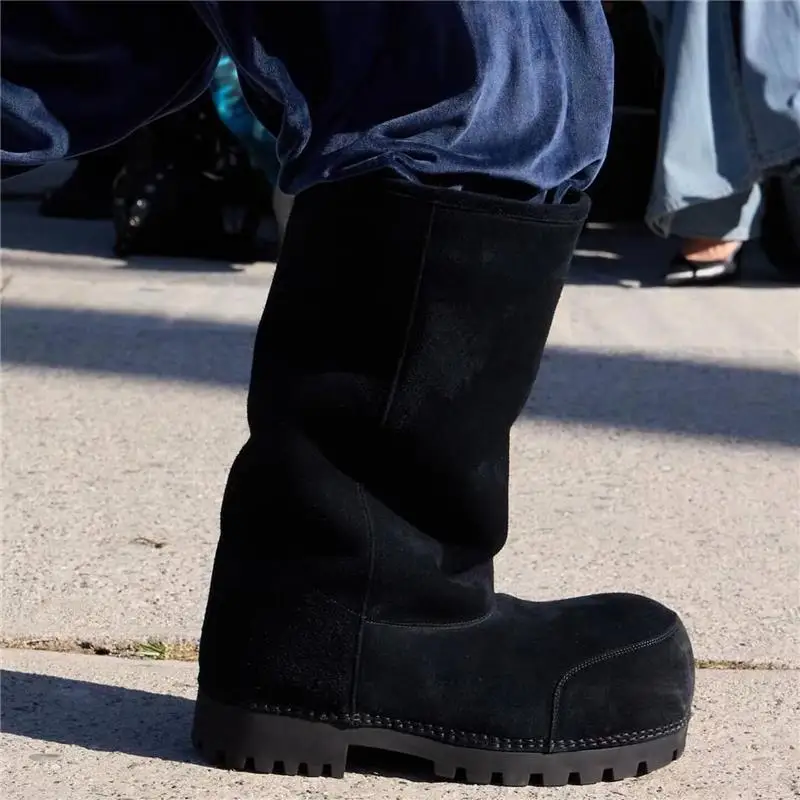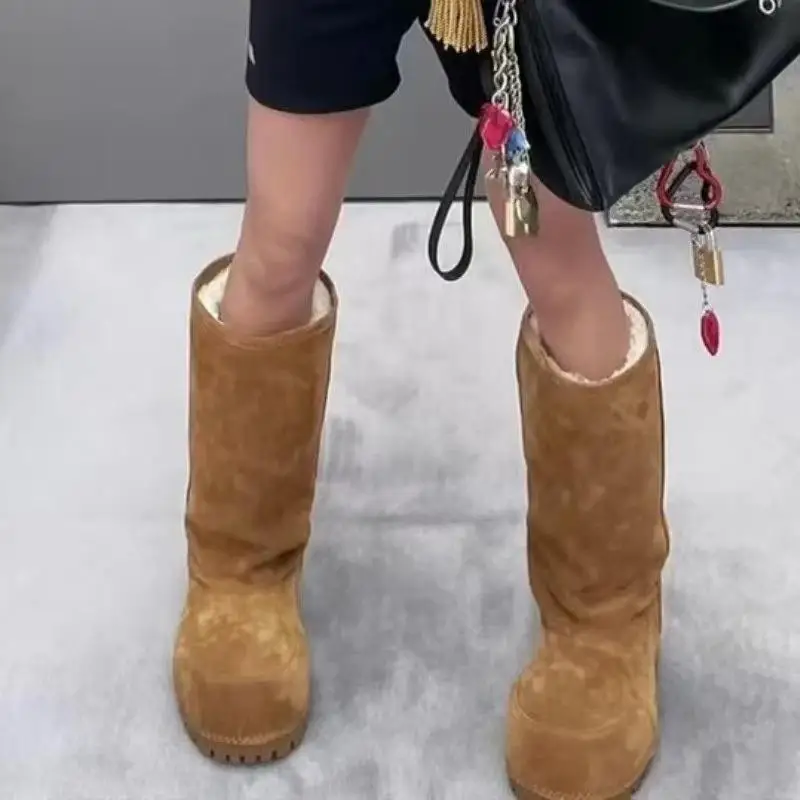The Rise of Ugly Boots in Modern Fashion
The fashion landscape is always evolving, and indeed, ‘ugly boots‘ have carved a notable niche within the industry. These shoes, which defy traditional beauty standards, are gaining momentum among both celebrities and the wider public. In recent times, we have witnessed an explosion of buzz around boots that many would deem unattractive or unconventional. But why the sudden popularity?

It seems that ugly boots represent a form of aesthetic rebellion. They challenge the conventional expectations of what footwear should look like. This trend includes designs like the inflated-red boots from Brooklyn-based MSCHF, which recently caught the internet’s attention. Despite their staggering price tags, these boots are not just walking off the shelves; they’re leaping. For instance, when they were launched, the Big Red Boots sold for four times their retail price on resale platforms such as StockX.
This surge in demand points to a deeper shift in how we perceive beauty and fashion. Ugly boots have transcended being a mere fad; they are now part of a broader fashion dialogue. It’s a conversation that asks us to re-examine our definitions of attractiveness and to find value and style in the places we least expect. This trend is also a reflection of the industry’s growing embrace of individuality and uniqueness, encouraging consumers to make bold statements with their choices in apparel.
The rise of ugly boots is not all about aesthetics, though – it is also about visibility. In a world overwhelmed with content and driven by viral trends, these boots stand out. They capture attention, make headlines, and ignite conversations both online and offline. As such, they fit perfectly into the social media era where virality and meme culture play a significant role in what becomes popular.
Aesthetic Rebellion: How Ugly Boots Challenge Conventional Beauty
The world of fashion thrives on the new, the unexpected, and sometimes, the outright odd. Enter ‘ugly boots,’ a term that at once captures the essence of a footwear revolution and challenges every known convention of shoe beauty. This isn’t about creating a new look but about crafting an aesthetic rebellion—one that dares to question the status quo of what’s deemed attractive.
These boots are deliberately chunky, garish, and oversized, serving as a bold statement against traditional design principles. They defy the sleek silhouettes and refined elegance that have long characterized the industry’s view of what constitutes as ‘good taste.’ Instead, they celebrate the quirky, the eccentric, and the exaggerated.
Unconventional, visually striking, and bursting with character, these styles aren’t just functional; they’re conversational pieces meant to provoke thought and perhaps even a chuckle. Their presence marks a stark departure from safe and predictable footwear, instead inviting us to find joy and playfulness in their unique form.
Celebrities and influencers have donned these boots, further propelling their popularity. By stepping out in these conspicuous concoctions, they’re tossing the gauntlet, inviting us all to embrace our individuality. It’s not just a matter of fashion but of personal expression and cultural identity.

Celebrity Endorsements and the Popularity Surge
The phenomenon of ‘ugly boots’ has not gone unnoticed by high-profile celebrities, whose endorsements have powered a significant surge in their popularity. Stars like Paris Hilton and Victoria Beckham have been spotted adorning these distinctive boots, creating a media buzz that rapidly translates into consumer interest. These celebrities often share images of themselves wearing these unconventional shoes on social media, reaching millions of their followers instantaneously.
This kind of celebrity influence acts as a powerful endorsement, validating ‘ugly boots’ as a stylish choice despite their nontraditional appearance. When a celebrity is seen wearing a particular fashion item, it often sets a trend, making the item instantly more desirable to the public. Consequently, their endorsements have a ripple effect throughout their fanbase and the broader public, which drives up demand for these quirky shoes.
Besides, the entertainment industry, including music videos and public appearances at fashion shows, has played a pivotal role in the ascent of ‘ugly boots.’ Performers such as Janelle Monáe and Lil Nas X have embraced these bold styles, incorporating them into their extravagant and eclectic aesthetics. Each occasion they are spotted in these boots, discussions and debates about ‘ugly boots’ stir up on various platforms ranging from Twitter to fashion blogs, heightening the boots’ visibility and desirability.
The surge in popularity is not just about aesthetics; it’s also about making a statement. ‘Ugly boots’ stand out due to their unique design, causing them to become a popular topic among fashion commentators and enthusiasts. This trend demonstrates a shift in how footwear can serve as a medium for individualistic expression and challenge traditional concepts of beauty in fashion.
From Satire to Staple: The Cultural Impact of Ugly Footwear
The rise of ugly boots is more than just a fashion trend—it’s a cultural shift. Initially seen as satirical commentary, these boots have become a staple in modern wardrobes. They’ve made their way from mockery to mainstream acceptance. They show us how humor and fashion can merge to make societal statements.
The boots’ bulky silhouettes and bold designs have sparked debates on traditional beauty. They’ve become symbols of anti-conformity, breaking norms and starting conversations. They’ve shown us that in fashion, rules can be bent or broken, and fun can be had.
Beyond fashion circles, ugliness in footwear has entered broader culture. These boots have become icons in the meme world. They’ve made appearances in digital media as symbols of quirky, audacious style. They’ve brought people together, creating a community of those who celebrate the unconventional.
In conclusion, ugly boots have proven that they are more than a passing fad. They have impacted the way we look at fashion, beauty, and cultural norms. They have become a symbol of the times—a sign that we are ready to embrace diversity in all its forms, even in our footwear choices.
The Economics of Ugly Boots: Resale Value and Consumer Demand
The marketplace for ‘ugly boots’ demonstrates fascinating economic dynamics, particularly in their resale value and consumer demand. Initially, these boots command high retail prices, as evidenced by MSCHF’s Big Red Boots which retailed at $350. However, their value skyrockets on secondary markets like StockX, where they have been known to fetch prices four times higher than retail shortly after release.
This price inflation is largely driven by limited edition releases and celebrity endorsements. High-profile figures wearing these boots instantly boost their desirability. Brands capitalize on this by keeping the supply deliberately low, which creates a frenzy among consumers eager to own or invest in a pair.
Additionally, ‘ugly boots’ maintain their economic allure by becoming trendy collector items. Their unique and often audacious designs make them stand out, appealing to niche markets and fashion enthusiasts who are willing to pay a premium for distinctive items.
Market trends suggest that as long as these boots remain popular in fashion circles and continue to be promoted by celebs, their resale value will likely remain high. This ongoing demand not only benefits manufacturers and initial retailers but also stimulates a vibrant resale market wherein consumers look to capitalize on their fashion investments.

Clearly, ‘ugly boots’ have transcended their initial market shock value and have established themselves as a lucrative niche in the footwear industry. Their journey from fashion statements to economic commodities reflects a shift in consumer behavior, where items of personal expression also serve as investment opportunities.
Function Versus Fashion: The Practicality Debate
When discussing the realm of ‘ugly boots,’ a critical conversation often arises: Function versus fashion. This debate stems from the fact that while these boots score high on uniqueness and visual appeal, their practical usage remains dubious to some.
Firstly, the unconventional shapes and sizes of these boots can spark doubts regarding comfort. Boots with bulbous, oversized designs may not offer the stability and ease typical of more standard footwear. Consumers face a trade-off; choosing boldness over traditional comfort.
Despite this, the popularity of these boots suggests that for many, fashion holds precedence over functionality. People are ready to sacrifice some comfort for style. Indeed, wearing such distinctive boots can serve as a form of personal expression or a way to stand out in a crowd.
Yet, it’s not all style without substance. Some users find the quirky designs amusing and fitting for specific occasions, like themed parties or avant-garde fashion events. Here, the boots do not merely act as clothing but also as a conversation starter.
In summary, while the practicality of ‘ugly boots’ might be questioned, their cultural impact and role in personal expression justify their place in the fashion landscape. They blend pronounced design with a bold statement about personal style and preferences, pushing the envelope on what footwear can represent.
Footwear as a Statement: What Ugly Boots Symbolize
Ugly boots do more than cover feet; they send messages. These boots symbolize a shift in fashion philosophy. They prove that fashion is not just about looking good. It’s about making a statement and sparking conversation.
Here are what ugly boots symbolize in modern fashion:
- Rebellion against Norms: They challenge traditional beauty standards. This shows in their unconventional designs.
- Individuality and Expression: By choosing these boots, wearers show their unique tastes. These choices speak to personal style over prevailing trends.
- Humor and Playfulness: Their exaggerated forms often evoke amusement. Fashion can be fun and not always serious.
- Cultural Commentary: Ugly boots reflect our culture’s appreciation for irony. They mix humor with fashion, making people re-think ‘normal’.
- Inclusivity: By embracing ‘ugly,’ the fashion world widens what is acceptable. This invites more people to express themselves through fashion without constraints.
In essence, ugly boots aren’t just footwear. They are a cultural artifact. They make us think and sometimes laugh.
Looking Ahead: The Future of Ugly Boots in Fashion Trends
As we consider the trajectory of ugly boots in the fashion world, several trends seem likely to surface.
- Increased Innovation and Experimentation: Designers will likely push boundaries further with even more daring and outlandish designs. This innovation will aim to continuously captivate and surprise the fashion audience.
- Sustainability Focus: With growing awareness about environmental impact, future designs of ugly boots may incorporate sustainable materials and eco-friendly production processes. This shift will cater to the eco-conscious shopper while maintaining the characteristic boldness of the boots.
- Broader Acceptance and Normalization: As the trend persists, what was once considered outlandish could become more normalized. This acceptance could see ugly boots becoming a regular sighting in everyday scenes, not just on runways and celebrity feet.
- Integration with Technology: Looking forward, there may be an integration of technology with fashion in the design of ugly boots. Features like LED displays or smart functionality could add a new dimension to the statement these boots already make.
- Collaboration with Other Fashion Segments: Potential collaborations with other fashion segments could be explored, blending traditional footwear with elements of ugly boots. This would create hybrid designs, further expanding the trend into new markets.
In essence, the future of ugly boots in fashion trends is poised for growth, diversification, and increasing acceptance, ensuring their continuation as a relevant and discussed element in the fashion industry.
